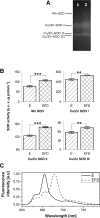The activity of superoxide dismutases (SODs) at the early stages of wheat deetiolation
- PMID: 29558520
- PMCID: PMC5860746
- DOI: 10.1371/journal.pone.0194678
The activity of superoxide dismutases (SODs) at the early stages of wheat deetiolation
Abstract
Unbound tetrapyrroles, i.e. protochlorophyllide (Pchlide), chlorophyllide and chlorophylls, bring the risk of reactive oxygen species (ROS) being generated in the initial stages of angiosperm deetiolation due to inefficient usage of the excitation energy for photosynthetic photochemistry. We analyzed the activity of superoxide dismutases (SODs) in etiolated wheat (Triticum aestivum) leaves and at the beginning of their deetiolation. Mn-SOD and three isoforms of Cu/Zn-SODs were identified both in etiolated and greening leaves of T. aestivum. Two Cu/Zn-SODs, denoted as II and III, were found in plastids. The activity of plastidic Cu/Zn-SOD isoforms as well as that of Mn-SOD correlated with cell aging along a monocot leaf, being the highest at leaf tips. Moreover, a high Pchlide content at leaf tips was observed. No correlation between SOD activity and the accumulation of photoactive Pchlide, i.e. Pchlide bound into ternary Pchlide:Pchlide oxidoreductase:NADPH complexes was found. Cu/Zn-SOD I showed the highest activity at the leaf base. A flash of light induced photoreduction of the photoactive Pchlide to chlorophyllide as well as an increase in all the SODs activity which occurred in a minute time-scale. In the case of seedlings that were deetiolated under continuous light of moderate intensity (100 μmol photons m-2 s-1), only some fluctuations in plastidic Cu/Zn-SODs and Mn-SOD within the first four hours of greening were noticed. The activity of SODs is discussed with respect to the assembly of tetrapyrroles within pigment-protein complexes, monitored by fluorescence spectroscopy at 77 K.
Conflict of interest statement
Figures





Similar articles
-
Early and late plastid development in response to chill stress and heat stress in wheat seedlings.Protoplasma. 2011 Oct;248(4):725-36. doi: 10.1007/s00709-010-0235-4. Epub 2010 Nov 10. Protoplasma. 2011. PMID: 21063735
-
Photoactive protochlorophyllide regeneration in cotyledons and leaves from higher plants.Photochem Photobiol. 2000 Nov;72(5):660-8. doi: 10.1562/0031-8655(2000)072<0660:pprica>2.0.co;2. Photochem Photobiol. 2000. PMID: 11107852
-
Transient etiolation: protochlorophyll(ide) and chlorophyll forms in differentiating plastids of closed and breaking leaf buds of horse chestnut (Aesculus hippocastanum).Tree Physiol. 2006 Aug;26(8):1087-96. doi: 10.1093/treephys/26.8.1087. Tree Physiol. 2006. PMID: 16651258
-
Characterization of two copper/zinc superoxide dismutases (Cu/Zn-SODs) from the desert beetle Microdera punctipennis and their activities in protecting E. coli cells against cold.Cryobiology. 2019 Apr;87:15-27. doi: 10.1016/j.cryobiol.2019.03.006. Epub 2019 Mar 16. Cryobiology. 2019. PMID: 30890324 Review.
-
Superoxide dismutases: active sites that save, but a protein that kills.Curr Opin Chem Biol. 2004 Apr;8(2):162-8. doi: 10.1016/j.cbpa.2004.02.011. Curr Opin Chem Biol. 2004. PMID: 15062777 Review.
Cited by
-
The effect of heavy metal contamination on humans and animals in the vicinity of a zinc smelting facility.PLoS One. 2019 Oct 28;14(10):e0207423. doi: 10.1371/journal.pone.0207423. eCollection 2019. PLoS One. 2019. PMID: 31658263 Free PMC article.
-
The Biochemical Properties of Manganese in Plants.Plants (Basel). 2019 Sep 27;8(10):381. doi: 10.3390/plants8100381. Plants (Basel). 2019. PMID: 31569811 Free PMC article. Review.
-
Adjustment of Photosynthetic and Antioxidant Activities to Water Deficit Is Crucial in the Drought Tolerance of Lolium multiflorum/Festuca arundinacea Introgression Forms.Int J Mol Sci. 2020 Aug 6;21(16):5639. doi: 10.3390/ijms21165639. Int J Mol Sci. 2020. PMID: 32781659 Free PMC article.
-
Insights Into Manganese Solubilizing Bacillus spp. for Improving Plant Growth and Manganese Uptake in Maize.Front Plant Sci. 2021 Nov 2;12:719504. doi: 10.3389/fpls.2021.719504. eCollection 2021. Front Plant Sci. 2021. PMID: 34795682 Free PMC article.
-
Molecular and Biochemical Analysis of Duplicated Cytosolic CuZn Superoxide Dismutases of Rice and in silico Analysis in Plants.Front Plant Sci. 2022 May 30;13:864330. doi: 10.3389/fpls.2022.864330. eCollection 2022. Front Plant Sci. 2022. PMID: 35707617 Free PMC article.
References
-
- Masuda T. Recent overview of the Mg branch of the tetrapyrrole biosynthesis leading to chlorophylls. Photosynth Res. 2008;96(2): 121–143. doi: 10.1007/s11120-008-9291-4 - DOI - PubMed
-
- Solymosi K, Schoefs B. Etioplast and etio-chloroplast formation under natural conditions: the dark side of chlorophyll biosynthesis in angiosperms. Photosynth Res. 2010;105(2): 143–166. doi: 10.1007/s11120-010-9568-2 - DOI - PubMed
-
- Brzezowski P, Richter AS, Grimm B. Regulation and function of tetrapyrrole biosynthesis in plants and algae. Biochim Biophys Acta. 2015;1847(9): 968–985. doi: 10.1016/j.bbabio.2015.05.007 - DOI - PubMed
-
- Yang J, Cheng Q. Origin and evolution of the light dependent protochlorophyllide oxidoreductase (LPOR) genes. Plant Biol. 2004;6: 537–544. doi: 10.1055/s-2004-821270 - DOI - PubMed
-
- Gabruk M, Mysliwa-Kurdziel B. Light-Dependent Protochlorophyllide Oxidoreductase: Phylogeny, Regulation, and Catalytic Properties. Biochemistry. 2015;54(34): 5255–5262. doi: 10.1021/acs.biochem.5b00704 - DOI - PubMed
Publication types
MeSH terms
Substances
LinkOut - more resources
Full Text Sources
Other Literature Sources

